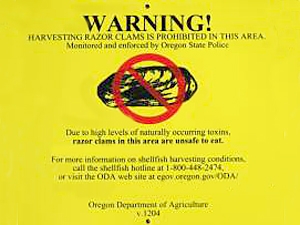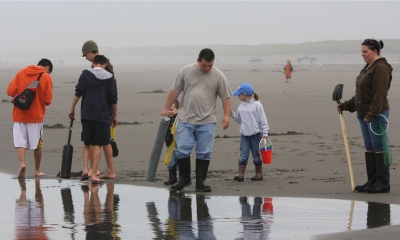
Shellfish and biotoxins
Razor clams and other bivalves are filter feeders that eat single celled plants called phytoplankton. Some species of phytoplankton manufacture biological toxins that, if ingested by bivalves, will be stored in their flesh. Though the biotoxins do not make the shellfish sick, they will make humans sick if a person consumes an affected animal.

Biological toxins
When a “bloom” of phytoplankton occurs, shellfish consume large numbers of them. Phytoplankton blooms that manufacture biological toxins are rarely associated with red or other colored tinges in the water. Although most common in summer months, phytoplankton blooms can occur and cause closures any time of the year. If humans, or other warm-blooded animals, eat contaminated clams, the stored toxin can affect the gastrointestinal and neurological systems.
There are two types of biological toxins that West Coast razor clams and other bivalves can be contaminated with, domoic acid (DA) and paralytic shellfish poisoning (PSP). Toxins are stored in the clams' necks, gills, digestive systems, muscles and gonadal tissues. Depuration rates (how fast the toxins leave the clam) vary depending upon the biotoxin, the level of contamination, the time of year, the species and the age of the clam. Lower levels can be flushed out in a matter of weeks while high levels may last years.
Domoic acid:
- Domoic acid, which causes amnesiac shellfish poisoning (ASP), is produced by a group of naturally occurring diatoms (Pseudo-nitzschia) that occasionally bloom off the West Coast. It was first discovered in razor clams in 1991 - razor clams, oysters, crab and mussels have been sampled routinely since then.
- The diatom and associated domoic acid is not new. However, our knowledge of its life history and the effects on humans is growing.
- Symptoms include vomiting, nausea, diarrhea, abdominal cramps, headache, confusion, dizziness, short-term memory loss and death. Symptoms usually occur between 24 and 48 hours after consuming contaminated shellfish.
- Razor clams tend to accumulate more domoic acid, and retain it longer, than bay clams. Mussels can accumulate high levels but it leaves the mussel in a matter of weeks.
- Domoic acid hasn't been found to hurt the razor clams themselves.
- Depuration rates of domoic acid in razor clams vary depending on the size of the clam. Toxicity in young clams can be reduced with clam growth, (juveniles grow rapidly, increasing body mass) reducing toxins quickly; whereas in older clams mass increases slowly, reducing toxin levels slowly.
- Due to the diatoms preference for oceanic areas, blooms containing domoic acid have more effect on ocean areas than in estuaries and bays.
- Freezing, cooking or other treatment has no effect on the toxin level in clams.
Paralytic Shellfish Poisoning (PSP):
- PSP accumulates in clams that ingest a naturally occurring dinoflagellate (Alexandrium sp.). PSP poisoning is a byproduct of a group of dinoflagellates which produce saxitoxins which affect the nervous system.
- People who eat shellfish that have been feeding on the toxic dinoflagellates can suffer from numbness, paralysis, disorientation and death. Symptoms may occur within hours of consumption.
- PSP can be found in razor clams, bay clams, mussels, scallops and oysters.
- PSP poisonings have been documented since 1799 when more than 100 Aleut hunters died in Alaska from eating contaminated mussels.
- Depuration rates vary depending upon contamination levels. Low levels usually flush out of the shellfish in a matter of weeks while high levels may never flush out.
- The PSP toxin is unaffected by temperature so neither cooking nor freezing reduces the toxin levels.
Sampling and Shellfish Safety Closures
- The Oregon Department of Agriculture (ODA) conducts bi-monthly sampling during the winter months and weekly sampling during the warmer months. Commercial and recreational shellfish species tested are: mussels, bay clams, crab, oysters and razor clams.
- Testing is for domoic acid and paralytic shellfish poisoning.
- Shellfish harvesting areas are closed to all harvesting when toxins exceed an "alert" level. Alert levels of 20 ppm for domoic acid, and 80 micrograms/100 grams for paralytic shellfish poisoning (PSP), provide a margin of safety and halt harvest before toxins reach a higher level that may cause illness.
- ODFW also monitors phytoplankton levels throughout the coast to help forecast domoic acid levels in razor clams.
- Check for current shellfish safety closures at ODA’s website or by calling the shellfish harvest hotline @ 1-800-448-2474
About Oregon Department of Agriculture testing and closure criteria
- Sampling of razor clams takes place coast-wide, when tides and weather permit. ODA and ODFW open razor clamming areas when results indicate the shellfish are safe to consume. There must be two consecutive sets of samples with results less than 20 ppm (parts per million) domoic acid and less than 80 micrograms/ 100 gms PSP toxins before an opening can be considered.
- All shellfish, clams, mussels, oysters and crab are monitored regularly for indications of any new harmful algae blooms. ODA and ODFW are also monitoring the toxigenic algae that produces domoic acid and the other shellfish toxin - paralytic shellfish poisoning (PSP). History has shown domoic acid levels in razor clams can double in less than five days. The public should stay alert for changes in the status of all shellfish harvesting area. Harvesters should check the ODA website and the shellfish information hotline (1-800-448-2474) to determine if the area they want to harvest is open.
Header photo by ConwaySuz, Flickr


